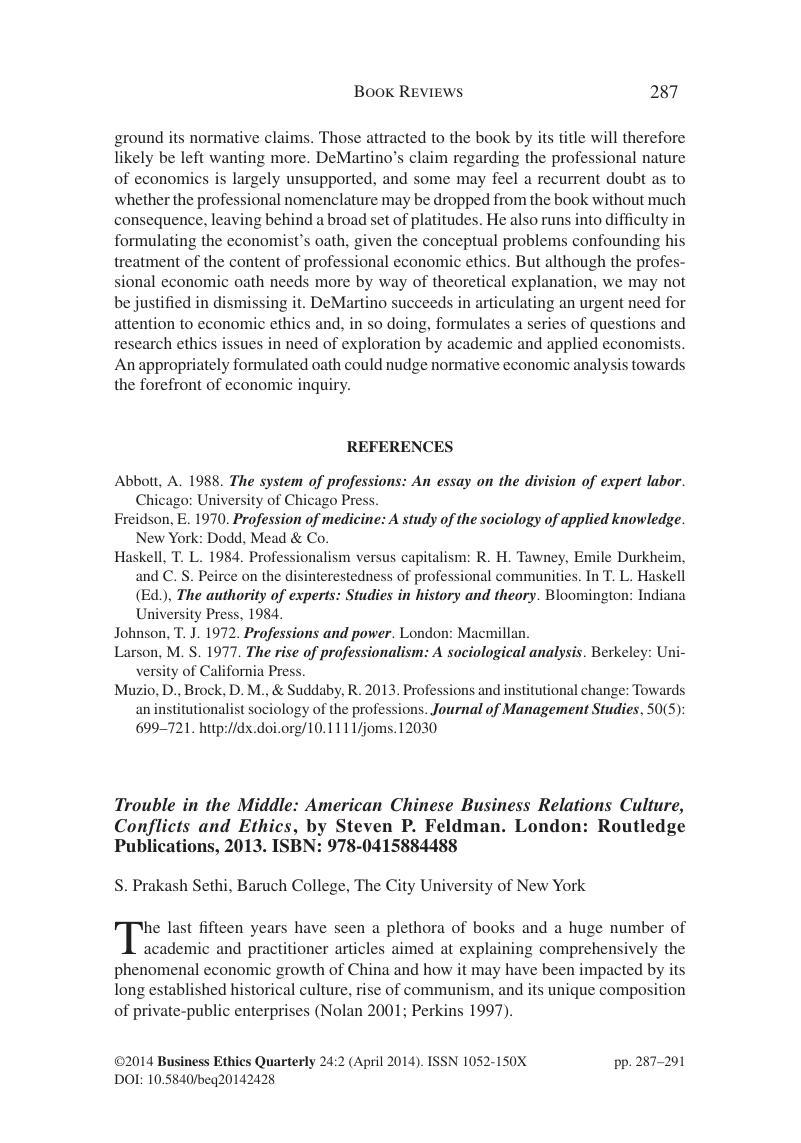No CrossRef data available.
Article contents
Trouble in the Middle: American Chinese Business Relations Culture, Conflicts and Ethics, by Steven P. Feldman. London: Routledge Publications, 2013. ISBN: 978-0415884488
Published online by Cambridge University Press: 23 January 2015
Abstract
An abstract is not available for this content so a preview has been provided. Please use the Get access link above for information on how to access this content.

- Type
- Book Reviews
- Information
- Copyright
- Copyright © Society for Business Ethics 2014
References
REFERENCES
Bremmer, Ian, and Stewart, Devin T.
2010 “China’s State Capitalism Poses Ethical Challenges,” Asia Times Online (17 August). http://www.atimes.com/atimes/China_Business/ LH17Cb01.html.Google Scholar
Broadman, Harry G.
2008 “China and India Go to Africa; New Deals in the Developing World,” Foreign Affairs
87: 95–109.Google Scholar
Chan, Anita
2001
China’s Workers Under Assault: The Exploitation of Labor in a Globalizing Economy
Armonk, N.Y.: M.E. Sharpe.Google Scholar
Chan, Christine M., Makino, Shige, and Isobe, Takehiko
2010. “Does Subnational Region Matter? Foreign Affiliate Performance in the United States and China,” Strategic Management Journal
31: 1226–43. http://dx.doi.org/10.1002/smj.854.Google Scholar
Fombrun, Charles, and Pan, Matthew
2006. “Corporate Reputations in China: How do Consumers Feel About Companies?,” Corporate Reputation Review
9: 165–70. http://dx.doi.org/10.1057/palgrave.crr.1550024
Google Scholar
Kent, Ann.
1999. China, the United Nations, and Human Rights: The Limits of Compliance. Philadelphia: University of Pennsylvania Press.Google Scholar
McElroy, Michael B., Nielsen, Chris P., and Lyndon, Peter
1998. Energizing China: Reconciling Environmental Protection and Economic Growth. Cambridge, Mass.: Harvard University Press.Google Scholar
Murray, Janet Y., Kotabe, Masaaki, and Zhou, Joe Nan
2005. “Strategic Alliance-Based Sourcing and Market Performance: Evidence from Foreign Firms Operating in China,” Journal of International Business Studies
36: 187–208. http://dx.doi.org/10.1057/palgrave.jibs.8400120.Google Scholar
Nolan, Peter.
2001. China and the Global Economy. New York: Palgrave. http://dx.doi.org/10.1057/9780230599284
Google Scholar
Panitchpakdi, Supachai, and Clifford, Mark L.
2002. China and the WTO: Changing China, Challenging World Trade. Singapore: John Wiley&Sons.Google Scholar
Perkins, Dwight.
1997. “History, Politics, and the Source of Economic Growth: China and East Asian Way of Growth,” in China in the Twenty-First Century: Politics, Economy, and Society, ed. Fumio, Itoh.
Tokyo: United Nations University Press.Google Scholar
Quanyu, Huang, Leonard, Joseph , and Tong, Chen
1997. Business Decision Making in China. New York: International Business Press.Google Scholar
Tan, Benjamin.
2002. “The Impact of National Environment on Managerial Value Systems:A Comparative Study of Chinese Managers in The United States, Singapore and the People’s Republic of China,”Management International Review
42: 473–86.Google Scholar
Tang, Ji, and Ward, Anthony
2003. The Changing Face of Chinese Management. London: Routledge.Google Scholar
Terrill, Ross.
2003. The New Chinese Empire: And What It Means for the United States. New York: Basic Books.Google Scholar
Zinzius, Birgit.
2004. Doing Business in the New China: A Handbook and Guide. Westport, Conn.: Praeger.Google Scholar
Zweig, David.
2002. Internationalizing China: Domestic Interests and Global Linkages. Ithaca, N.Y.: Cornell University Press.Google Scholar




